In the late 1860s, the young scamps of the Methodist Camp Ground, in what was then still a part of Edgartown, would sneak out after evening worship to hang out in the new neighborhood that was blooming next door. “Going Bluffing,” they called it, and whenever they didn’t make it back to the Camp Ground by the 10 p.m. curfew, they would sneak back inside through the guarded gates.
Yes, gates – to the very Camp Ground that sits wide open to the public today in the heart of the independent town of Oak Bluffs. At some point before 1870 the Martha’s Vineyard Camp Meeting Association built a wall, so to speak – a seven-foot-high picket fence – in an effort to shield the pious community from the temptations of the worldly resort emerging at alarming speed outside its borders. “Lots were being sold, cottages were being built, everything booming,” recalled one-time “Bluffer” Lucy Vincent Smith in 1929 of the energy outside the Camp Ground wall in her youth. And on the nearby knoll where Kennebec, Circuit, Samoset, Narragansett, and Grove Avenues met, “A lot for [a] chapel had a few trees cut down and a sign marked ‘Chapel Hill’ placed on it,” she observed.
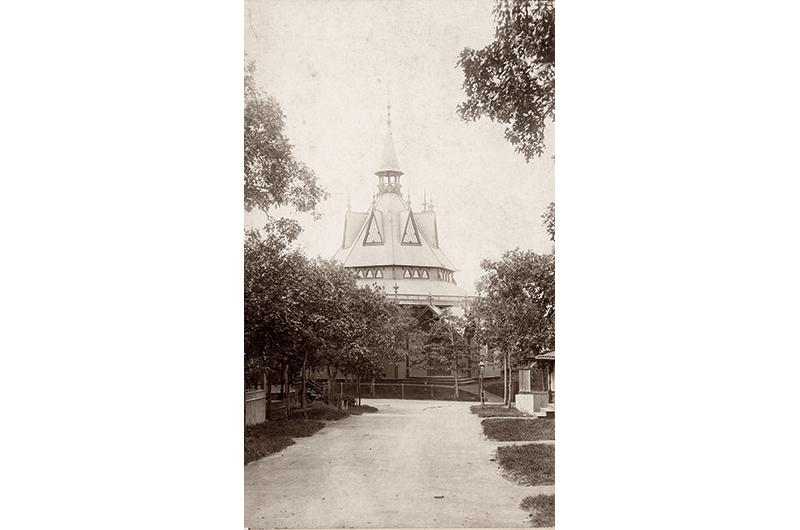
Like the young scamps, the Oak Bluffs Land & Wharf Company and other resort speculators were miffed by the fenced-in vibe of the camp meetings. The summer community outside the pickets had no alternate place of worship, so the developers thus earmarked Chapel Hill and commissioned Oak Bluffs’ foremost architect of the day – Samuel Freeman Pratt of Boston – to put his imagination to work on a fitting edifice. As reported in 1870 in the Vineyard Gazette: “This is to be really a unique affair and a decided monument to the locality. It is to be free to preachers of every theological complexion (including of course the Liberals) so that all will have an opportunity of hearing the truth as they believe it.” Within the boundaries of Protestantism, that is.
Hence the name Union. And furthermore, the name Chapel. For this would be no mere tent, à la the Camp Ground’s canvas precursor to its Tabernacle. Costing some $16,000, Union Chapel was arguably the pièce de résistance of Pratt’s estimated twenty-two structures that rose during Oak Bluffs’ fast-track building boom between 1870 and 1872. At ninety-six feet of soaring Victorian splendor, Union Chapel was the tallest of them – for a year anyway, until Pratt’s own Sea View Hotel bested the building by four feet, or twenty if you counted the flagpole.
Conceived in the liberal spirit, the chapel is a massive octagon with four breezy double-door entrances, each over seven feet wide and nearly eight feet tall, with covered porches and double-gabled roofs. Four seven-foot-high windows brighten the exterior on even the dullest of days. Is it appropriate to say a house of God was once awash in go-to-hell ornamentation? An octagonal spire hovered over the roof on graceful rods, stretching the building to its record-breaking height and the heavens above. Every gable sported a fancy wrought-iron spire. A bell tower graced the main entrance. Mega-mullioned transom and triangular windows encircled the building. A 360-degree balcony sported fretted woodwork, a.k.a. “gingerbread.”
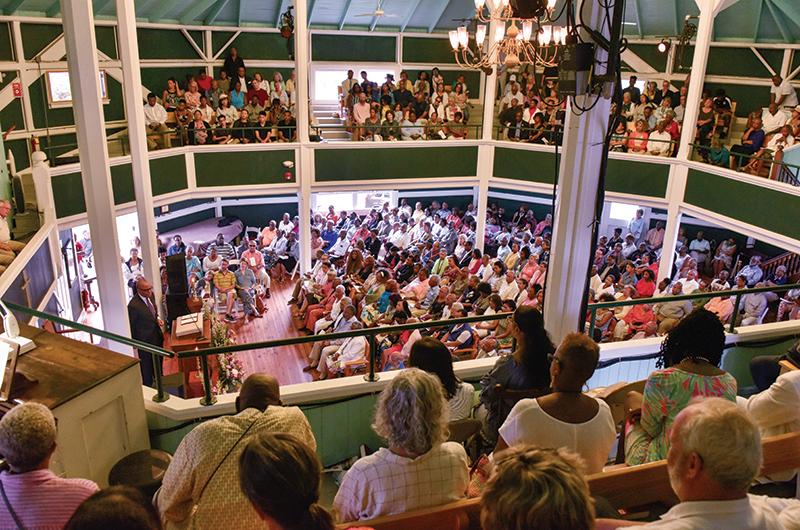
A century-and-a-half of storms and decay have taken a toll on the flourishes that once softened the octagon’s exterior, and today’s Union Chapel is a quieter and squattier version of its former self. By contrast, the interior of the building suggests a Puritan sensibility, then and now. The towering ceiling remains faithfully supported by eight massive pillars. Eight rafters meet at the highest height, forming an eight-pointed star. From the apex hangs an oversized Williamsburg chandelier. A seating balcony rims five of the chapel’s eight sides.
Like everything else in the neighborhood, it went up quickly. Contracts were signed in March of 1871 and five months later, 150 years ago this August 20, Union Chapel was dedicated. It was no small affair. Eight visiting preachers of various denominations came from across New England and as far as New York and New Jersey to address the congregation, beginning the summer tradition of a rotation of visiting preachers at the chapel. Even the Camp Meeting directors accepted the invitation to attend.
The Park Street Church Choir of New York City sang the “Credo” from La Hache’s Mass for Peace, beginning the equally long tradition of fine offerings by musicians with national reputations. Some chapel music directors were organists of note, and by the 1920s they were tiring of the chapel’s old-timey, hand-pumped reed organ, which required the labors of two human pumpers alongside the organist. Plus, the organ was compromised anyway: during building repairs in 1913, the chapel’s rotting high spire was in the process of removal when it slipped and harpooned both the roof and the organ beneath it. A new state-of-the-art organ, installed in 1924, gleamed with an elaborate course of 800 pipes and required a downsizing of the chapel’s choir loft to the quartet-sized mini-loft still in use today. By 1938, the organ had gradually swelled to 1,200 pipes.
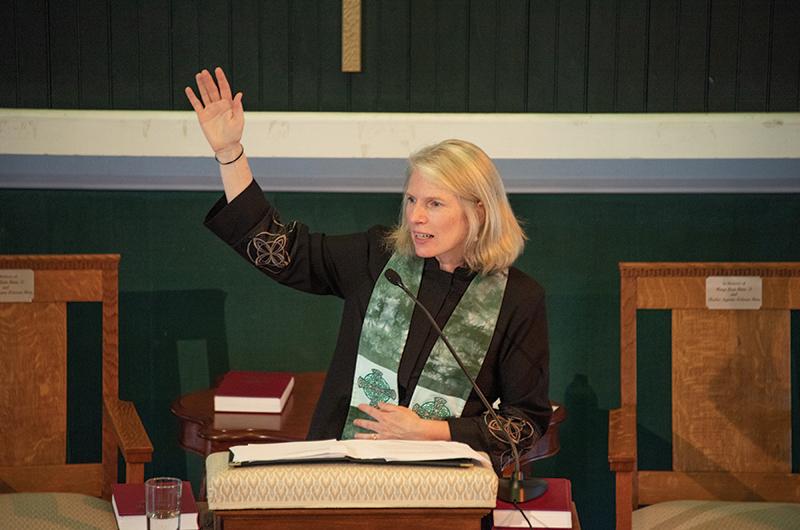
Whether it’s the exterior façade or the organ and choir loft, Union Chapel has evolved over the years in the way it looks and, arguably more so, in the way it serves. Yet this much prevails: Union Chapel was progressive in its mission at its onset, and it remains so today. Just add belly dancers. And then some.
From the very beginning there were secular diversions, such as political lectures and dramatic readings. There were meetings of the subversives, if you will, of the Oak Bluffs secessionist movement. And in 1880, when the town won its independence from Edgartown, Union Chapel was the site of the public gala, which doubled as the first town meeting. These continue today. The Built on Stilts dance festival, for instance – cue the belly dancers – is still going strong after twenty years. In 1997, crowds packed the chapel for a ninetieth birthday celebration for Harlem Renaissance writer and Oak Bluffs icon Dorothy West. Jessye Norman of the Metropolitan Opera sang; First Lady Hillary Clinton gave tribute. It was also at Union Chapel that then-President Bill Clinton took part in a 1998 anniversary celebration for the 1963 March on Washington.
Did the pulpit get to him? Was it the throes of the Ken Starr investigation? His remarks were as long and impassioned as a southern preacher’s and seemed to many to be the first time he took a measure of personal responsibility for his troubles. Union Chapel drew national television news coverage that day.
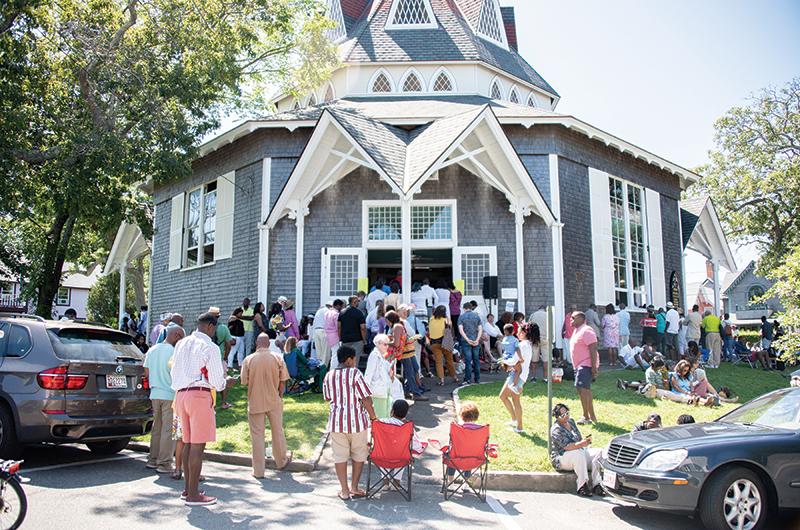
“Is this the Black church?”
Trustee emeritus Mildred Henderson was doing usher duties at her usual post one Sunday a few summers ago. A visitor approached, wanting to be sure she had arrived at the right place – the Black church she’d heard about.
“No, this isn’t a Black church,” Henderson gently informed her.
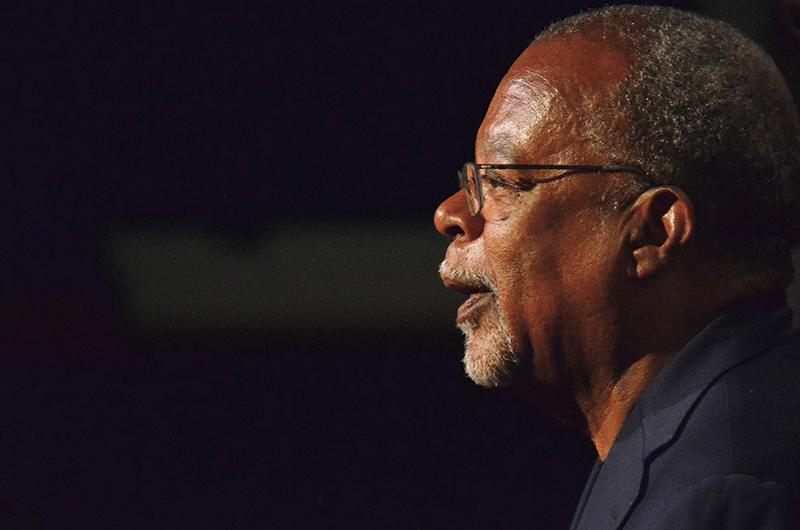
“Are you sure?”
The puzzled visitor undoubtedly observed the stream of congregants flowing past her through the double doors, hailing friends and filling pews. Most likely, the majority of faces belonged to persons of color – as did Henderson’s. It looked, in other words, like a “Black church.”
But say the words “Black church” to any Union Chapel trustee; a swift and cordial counter will follow. Chapel leaders extoll Union Chapel as a diverse church, a multicultural church, a welcoming church. But not, by design, a Black church – despite a profusion of complexions, sermons, and African-inspired collection baskets suggesting otherwise on many a Sunday.
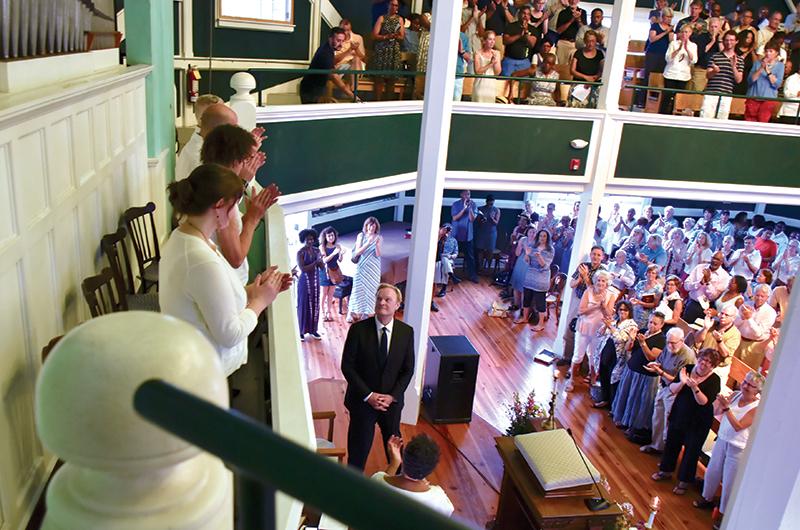
Henderson died in the winter of 2020. Fortunately, her reflections on the evolution of Union Chapel’s diversity did not die with her. In 1956, she and her sisters Ruth and Kathy bought a summer cottage just up the street. Their parents were regular visitors from the start. They were in the first wave of African American families who settled in the nearly abandoned streets south of Ocean Park during the post–World War II era. Collectively, they resurrected the heart of the resort created by the Oak Bluffs visionaries of yore. Union Chapel was a stroll away, and African American families found welcome there. “Daddy went to Union Chapel from the day he set foot on-Island and was active till the day he died in 1984,” she recalled.
It was chapel member Stan Hart of Oak Bluffs’ Harthaven community who bade Luther J. Dowdell to attend. Hart was among Dowdell’s well-heeled customers who kept automobiles in his Hartford, Connecticut, garage. By the 1970s, Dowdell was named a Union Chapel trustee and, in time, a vice president. And in the tradition of trustees, Dowdell invited his home minister – the Reverend Blake of Shiloh Baptist Church in Hartford – to come preach. Blake was only the second Black minister to preach from Union Chapel’s pulpit, according to Henderson.
In something of a chicken-and-egg phenomenon, the numbers of African American preachers and congregants alike have gradually risen to the present day. Ditto for the numbers of trustees and officers. And for visiting worshipers of renown, such as the late Vernon Jordan and late Congressman John Lewis. Somewhere along the line, Union Chapel reached a tipping point in its outward racial profile.
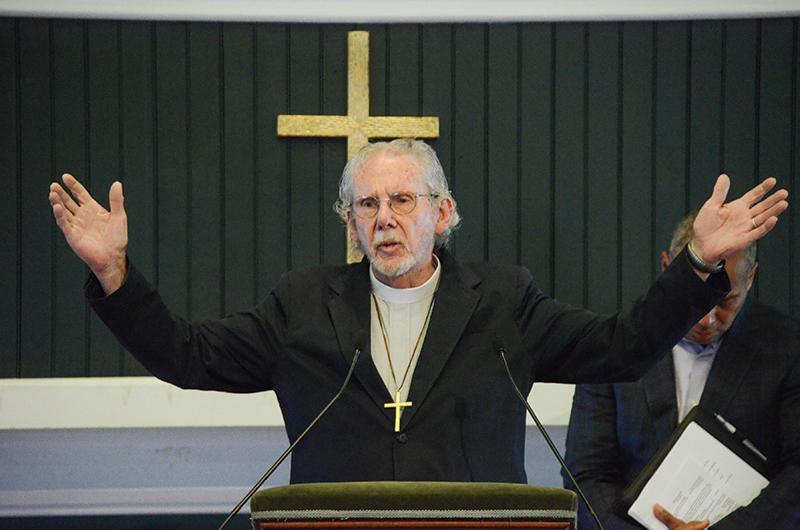
“Back in the seventies, the racial makeup of the congregation seemed to be about fifty-fifty,” Heidi Bryan recalled. “It has certainly evolved.” She is unfazed by the tip in the scales in the years since. “The community surrounding the chapel is mostly African American. We welcome all. I love the familial association within the building.” She allows that she knows individuals – “not trustees,” she emphasized – who are not as comfortable as she is with the degree of cultural shift. Bryan’s grandparents James and Louise Sanders were members, her father Chuck Sanders was a longtime trustee, and she herself has been on the board since 2014. “I get this feeling of joy, helping the chapel face its challenges and grow. I love being part of a structure where any and all may enter. That’s why all those doors are there.”
In tandem with the cultural shift, there’s been a growth spurt in the impact of African American donors – the latter-day Union Chapel “pillars.” Henry Louis Gates Jr. funded the restoration of the pulpit furnishings. Individuals of quieter profile amassed $75,000 in a matter of days for wooden pews to replace the chapel’s old cane chairs. Others chipped in with a donation for pew cushions, which weren’t even on the chapel’s wish list.
When Gates got the nod from PBS to produce a documentary based on his book about the Black church, he sought permission from Union Chapel to tape a worship service there. He got the we’re-not-a-Black-church advisory, compliments of board president Richard Taylor, who happens to be the second African American to rise to the post. Nevertheless, permission to film was granted and in August of 2019 crews taped a service featuring the Reverend Otis Moss III of Chicago, a frequent guest renowned nationally for his scholarship as well as his rousing sermons.
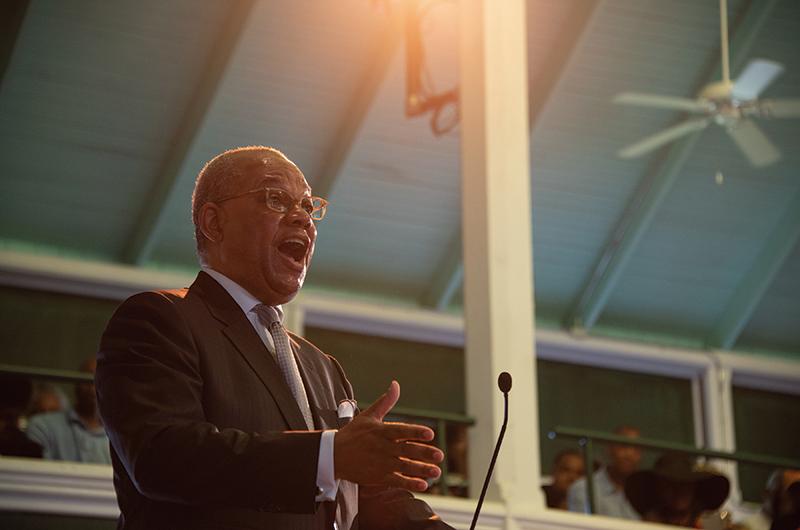
Indeed, the Union Chapel tradition of inviting hometown preachers has given way to outreach to rock stars of the ministerial world. Similarly, the chapel’s annual “Lay Sunday,” featuring speakers in lieu of preachers, draws the occasional household name, such as former Massachusetts Governor Deval Patrick and MSNBC’s Lawrence O’Donnell. On these super Sundays, the chapel fills to overflowing as much as an hour before the organ prelude. Some congregants settle for folding chairs on the lawn outside the open doorways. Others stand on tiptoes to peer inside the windows.
Today’s messages from the pulpit often incline toward social issues – border walls, for example, or Black Lives Matter. It’s hardly the way Union Chapel sermons used to be. “For churches to remain viable, ministers have to relate to the world in which people live,” said Taylor. “The only antidote to death is change. We’re not the Union Chapel of 100, fifty, or even twenty-five years ago. And guess what? In the next twenty-five, fifty, and 100 years, Union Chapel will change again.” As for not being a Black church: “Union Chapel is whatever it is to you. All are welcome. Join us.”
Trustee Robert Jennings does double duty as Union Chapel facilities manager. In summer, if he isn’t in residence in the family’s Oak Bluffs cottage, he gets up on Sundays at home in Worcester, Massachusetts, hits the road by 3:30 a.m., and boards the first ferry from Woods Hole. He opens the church just after 7 a.m., sets up the altar furnishings, puts out the hymnals, and raises the window sashes, each weighing some fifty pounds. During services, he still stands in the spot where his mother, Betty Jennings, a well-known operatic soprano who sang in the choir for decades before her death in 2010, could see him from the loft and feel supported.
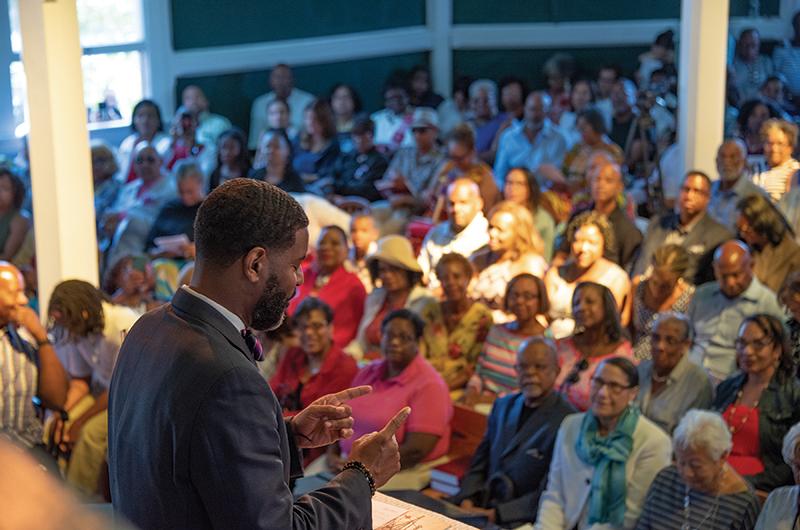
“It’s like the eight pillars holding up the church,” said Jennings. “This job has become one of the most important parts of my life.”
The heavier lifting of facilities management – updates and repairs – used to be wholly supported by the chapel’s human pillars, as they called themselves. They largely represented families who’ve been devoted members of the chapel for generations, some since the days when horse-drawn surreys carried them from East Chop and elsewhere to Sunday services. The chapel had no endowment to fall back on, but that was okay. One pillar or another could always be counted on to dig quietly into a pocket when something needed fixing.
Like any aging grand dame, however, the chapel required bigger and costlier maintenance over time. By the dawn of the twenty-first century, a lot of work had been deferred way too long. The chapel president at the time, James Bryan, had been attending services since the 1930s, when he was a young boy summering in East Chop. Union Chapel was in his blood. He asked Chris Scott, then the executive director of the Martha’s Vineyard Preservation Trust (now the Vineyard Trust), for advice on launching an endowment campaign. “All of a sudden I realized that Chris was leading the conversation,” Bryan told the Vineyard Gazette in 2002. And lo, the Trust purchased Union Chapel from the Oak Bluffs Christian Union (OBCU) – for one dollar, which is the standard fee the organization pays for any property acquisition.
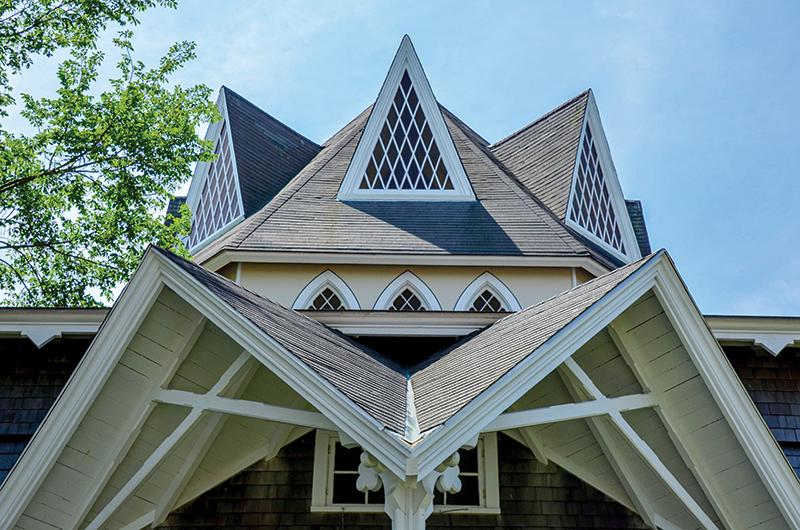
“He made all the difference to the chapel’s survival,” said Will Bryan, speaking of his father, who died in 2005. As part of the arrangement, the OBCU retained priority usage of the chapel for worship and other activities in fulfillment of its religious mission while the Trust took on the care and feeding of the building and assumed the right to rent it out for other uses – private weddings, public concerts, and such. In part with the income from those events, the Trust has completed a whole lot of work in twenty years: roof and window replacements, stage lighting, accessibility ramps, paint jobs, floor restorations, electrical upgrades.
As 2020 dawned, Union Chapel was poised to mark its 150th anniversary in big fashion. Celebrations were in development. The building was freshly shingled. A major restoration of the near-centenarian pipe organ, which had been dismantled and shipped to Boston in the fall, was scheduled to be reinstalled in the spring. The season’s calendar was filling with preachers, book talks, concerts, weddings, Built on Stilts, and on and on.
Enter Covid-19 in March. She was having none of it. She did bestow a few mercies, however: “Covid actually encouraged us to do something we should have been doing for a long time,” said board president Taylor, referring to the introduction of virtual worship services. Kharma Finley, the chapel’s social media guru, edited and uploaded prerecorded services that streamed for ten summer Sundays, drawing hundreds of online worshipers from across the country and just up the street. “Visiting” preachers led the services from their own home pulpits. Although the chapel organ was still in Waltham, waiting out Spencer Organ Company’s own Covid disruptions, music director Bill Peek had workarounds. He accompanied members of the quartet individually on the chapel’s Steinway and performed organ solos from the First Congregational Church of West Tisbury.
The otherwise mothballed chapel was brought back to life for a week last summer by artist-in-residence Kevin Sampson, and his work in progress on a large, ornate sculpture that captivated passersby outside the open doors. And once the organ arrived back on Island, in thousands of pieces, no bridal processions or tap dancers were in the way of its reinstallation. The work was completed in October.
Covid did not deter the chapel from launching a charitable partnership in December with the Island Food Pantry and Island Grown Initiative, starting with a successful matching fund challenge. Nor did it prevent the chapel’s 150th Anniversary Capital Campaign, launched in 2019, from raising some $350,000. “I’ve been blown away by this community’s support for Union Chapel,” said trustee Al Johnson, who served as campaign chair. “Just mention you’re raising money and some individuals fall right in.”
Chief among the aims of the campaign was to recoup the organ restoration expense, budgeted at nearly a quarter million dollars. It was long overdue. The state of deterioration was so severe, it typically took ten seconds for organist Peek to get the “swell” button to engage. Today the restored instrument gleams with a course of forty burnished brass pipes behind the choir loft – quite the visual departure from the silver-toned pipes they replaced. This, thanks to the surprise discovery of the old 1924 pipes, casually piled up and corroding in the attic since the last restoration in the 1960s. Historic virtue has been revived along with their luster. “They’re just dummies now,” disclosed Peek, “for decoration.”
No matter. Now the Union Chapel community looks forward to raising their voices – in person or virtually – as their state-of-the-art instrument plays…
“Happy anniversary to you….”

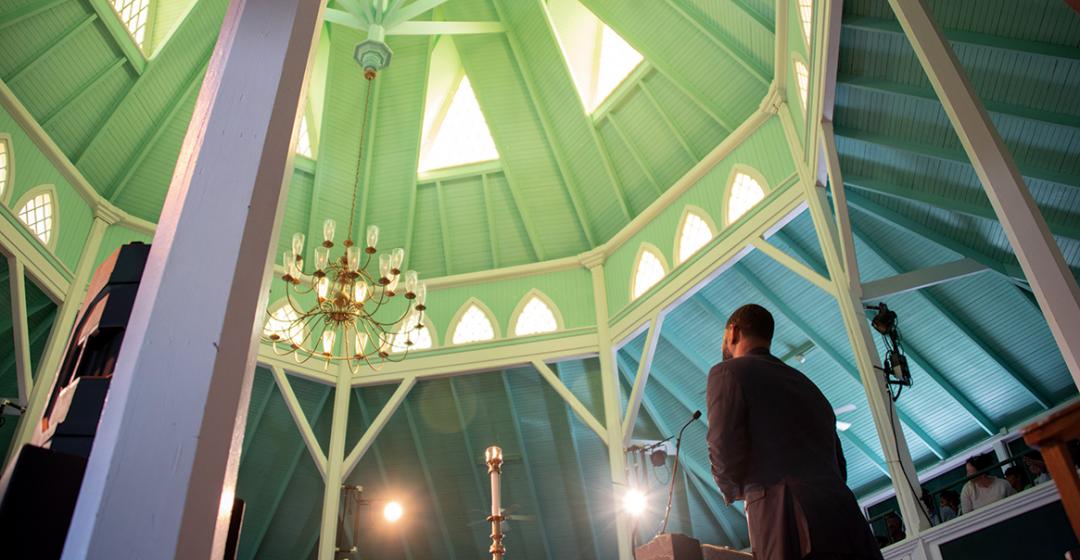


 1 comment
1 comment
Comments (1)